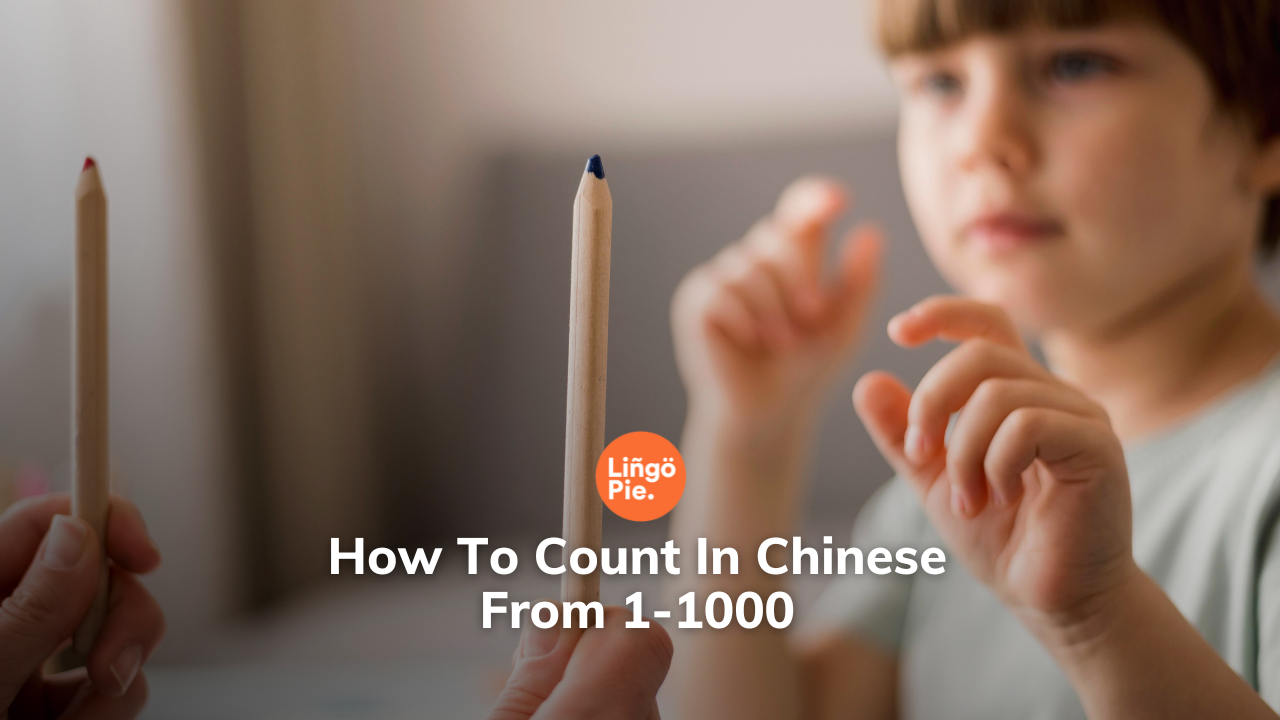In Chinese culture, numbers aren't just for counting; they carry loads of meaning and superstition. From lucky numbers bringing good fortune to unlucky ones to avoid, numbers play a big role in daily life.
Chinese numbers have their own way of working, with unique characters for each digit and specific rules for building bigger numbers. In this guide, we'll dive into counting from 1 to 1000 in Chinese, covering pronunciation, usage, and cultural quirks.

Basic Numbers (1-10)
In Chinese, mastering the basic numbers from 1 to 10 is the first step to fluency. Let's break it down:
- One: 一 (yī)
- Two: 二 (èr)
- Three: 三 (sān)
- Four: 四 (sì)
- Five: 五 (wǔ)
- Six: 六 (liù)
- Seven: 七 (qī)
- Eight: 八 (bā)
- Nine: 九 (jiǔ)
- Ten: 十 (shí)
Pronouncing these numbers might feel like a tongue-twister at first, but with a little practice, you'll get the hang of it! These basic numbers lay the foundation for expressing quantities in Chinese, so it's essential to get them down pat! Now, let's put them into action with some example sentences.
"我有一本书" (Wǒ yǒu yī běn shū) means "I have one book," while "他有四个朋友" (Tā yǒu sì gè péngyǒu) translates to "He has four friends."
Counting in Tens (11-100)
When it comes to counting in Chinese from 11 to 99, understanding the pattern is key. Essentially, you combine the words for ten (十, shí) with the basic numbers (1-9) to form the numbers in this range.
For example, to say eleven, you simply say 十一 (shí yī), where 十 (shí) means ten and 一 (yī) means one. Similarly, twelve is 十二 (shí èr), thirteen is 十三 (shí sān), and so on. Pronouncing these numbers follows the same pattern as before, with the basic numbers retaining their individual sounds. For instance, twenty-one is pronounced as 二十一 (èr shí yī), and thirty-five is 三十五 (sān shí wǔ).
Let's put these numbers into context with some example sentences. "我的生日是十二月十五号" (Wǒ de shēngrì shì shí èr yuè shíwǔ hào) means "My birthday is on December 15th," while "今天是二十三号" (Jīntiān shì èr shí sān hào) translates to "Today is the 23rd." Understanding this pattern makes counting in Chinese from 11 to 99 much simpler and lays the groundwork for expressing larger quantities.

- Eleven: 十一 (shí yī)
- Twelve: 十二 (shí èr)
- Thirteen: 十三 (shí sān)
- Fourteen: 十四 (shí sì)
- Fifteen: 十五 (shí wǔ)
- Sixteen: 十六 (shí liù)
- Seventeen: 十七 (shí qī)
- Eighteen: 十八 (shí bā)
- Nineteen: 十九 (shí jiǔ)
- Twenty: 二十 (èr shí)
- Twenty-one: 二十一 (èr shí yī)
- Twenty-two: 二十二 (èr shí èr)
- Twenty-three: 二十三 (èr shí sān)
- Twenty-four: 二十四 (èr shí sì)
- Twenty-five: 二十五 (èr shí wǔ)
- Twenty-six: 二十六 (èr shí liù)
- Twenty-seven: 二十七 (èr shí qī)
- Twenty-eight: 二十八 (èr shí bā)
- Twenty-nine: 二十九 (èr shí jiǔ)
- Thirty: 三十 (sān shí)
- Thirty-one: 三十一 (sān shí yī)
- Thirty-two: 三十二 (sān shí èr)
- Thirty-three: 三十三 (sān shí sān)
- Thirty-four: 三十四 (sān shí sì)
- Thirty-five: 三十五 (sān shí wǔ)
- Thirty-six: 三十六 (sān shí liù)
- Thirty-seven: 三十七 (sān shí qī)
- Thirty-eight: 三十八 (sān shí bā)
- Thirty-nine: 三十九 (sān shí jiǔ)
- Forty: 四十 (sì shí)
- Forty-one: 四十一 (sì shí yī)
- Forty-two: 四十二 (sì shí èr)
- Forty-three: 四十三 (sì shí sān)
- Forty-four: 四十四 (sì shí sì)
- Forty-five: 四十五 (sì shí wǔ)
- Forty-six: 四十六 (sì shí liù)
- Forty-seven: 四十七 (sì shí qī)
- Forty-eight: 四十八 (sì shí bā)
- Forty-nine: 四十九 (sì shí jiǔ)
- Fifty: 五十 (wǔ shí)
- Fifty-one: 五十一 (wǔ shí yī)
- Fifty-two: 五十二 (wǔ shí èr)
- Fifty-three: 五十三 (wǔ shí sān)
- Fifty-four: 五十四 (wǔ shí sì)
- Fifty-five: 五十五 (wǔ shí wǔ)
- Fifty-six: 五十六 (wǔ shí liù)
- Fifty-seven: 五十七 (wǔ shí qī)
- Fifty-eight: 五十八 (wǔ shí bā)
- Fifty-nine: 五十九 (wǔ shí jiǔ)
- Sixty: 六十 (liù shí)
- Sixty-one: 六十一 (liù shí yī)
- Sixty-two: 六十二 (liù shí èr)
- Sixty-three: 六十三 (liù shí sān)
- Sixty-four: 六十四 (liù shí sì)
- Sixty-five: 六十五 (liù shí wǔ)
- Sixty-six: 六十六 (liù shí liù)
- Sixty-seven: 六十七 (liù shí qī)
- Sixty-eight: 六十八 (liù shí bā)
- Sixty-nine: 六十九 (liù shí jiǔ)
- Seventy: 七十 (qī shí)
- Seventy-one: 七十一 (qī shí yī)
- Seventy-two: 七十二 (qī shí èr)
- Seventy-three: 七十三 (qī shí sān)
- Seventy-four: 七十四 (qī shí sì)
- Seventy-five: 七十五 (qī shí wǔ)
- Seventy-six: 七十六 (qī shí liù)
- Seventy-seven: 七十七 (qī shí qī)
- Seventy-eight: 七十八 (qī shí bā)
- Seventy-nine: 七十九 (qī shí jiǔ)
- Eighty: 八十 (bā shí)
- Eighty-one: 八十一 (bā shí yī)
- Eighty-two: 八十二 (bā shí èr)
- Eighty-three: 八十三 (bā shí sān)
- Eighty-four: 八十四 (bā shí sì)
- Eighty-five: 八十五 (bā shí wǔ)
- Eighty-six: 八十六 (bā shí liù)
- Eighty-seven: 八十七 (bā shí qī)
- Eighty-eight: 八十八 (bā shí bā)
- Eighty-nine: 八十九 (bā shí jiǔ)
- Ninety: 九十 (jiǔ shí)
- Ninety-one: 九十一 (jiǔ shí yī)
- Ninety-two: 九十二 (jiǔ shí èr)
- Ninety-three: 九十三 (jiǔ shí sān)
- Ninety-four: 九十四 (jiǔ shí sì)
- Ninety-five: 九十五 (jiǔ shí wǔ)
- Ninety-six: 九十六 (jiǔ shí liù)
- Ninety-seven: 九十七 (jiǔ shí qī)
- Ninety-eight: 九十八 (jiǔ shí bā)
- Ninety-nine: 九十九 (jiǔ shí jiǔ
Hundreds (100-900)
In Chinese, expressing multiples of 100 follows a straightforward pattern. The character for hundred is 百 (bǎi), and when combined with numbers, it forms the multiples of 100. For instance, 一百 (yī bǎi) represents one hundred, 二百 (èr bǎi) means two hundred, 三百 (sān bǎi) stands for three hundred, and so on up to nine hundred, which is 九百 (jiǔ bǎi).
Here's a pronunciation guide for each hundred:
- One hundred: 一百 (yī bǎi)
- Two hundred: 二百 (èr bǎi)
- Three hundred: 三百 (sān bǎi)
- Four hundred: 四百 (sì bǎi)
- Five hundred: 五百 (wǔ bǎi)
- Six hundred: 六百 (liù bǎi)
- Seven hundred: 七百 (qī bǎi)
- Eight hundred: 八百 (bā bǎi)
- Nine hundred: 九百 (jiǔ bǎi)
To illustrate the use of multiples of 100, here are some example sentences:
"那辆车价值五百美元。" (Nà liàng chē jiàzhí wǔ bǎi měiyuán.) - "That car is worth five hundred dollars."
"她家有三百个书籍。" (Tā jiā yǒu sān bǎi gè shūjí.) - "Her family has three hundred books."
"公司有六百名员工。" (Gōngsī yǒu liù bǎi míng yuángōng.) - "The company has six hundred employees."
Combining Hundreds and Tens (101-999)
In Chinese, forming numbers between 101 and 999 involves combining the concepts of hundreds and tens. The structure typically follows the pattern of "[hundreds] [tens] [single digit]." For example, to express 101, you would say 一百零一 (yī bǎi líng yī), where 一百 (yī bǎi) means one hundred, 零 (líng) means zero, and 一 (yī) represents one. Similarly, for 256, you would say 二百五十六 (èr bǎi wǔ shí liù), where 二百 (èr bǎi) means two hundred, 五十 (wǔ shí) means fifty, and 六 (liù) means six. This pattern continues for all numbers between 101 and 999.
Here's a pronunciation guide for numbers in this range:
- 101: 一百零一 (yī bǎi líng yī)
- 256: 二百五十六 (èr bǎi wǔ shí liù)
- 399: 三百九十九 (sān bǎi jiǔ shí jiǔ)
Let's see how these numbers are used in context:
"这家餐厅的菜单上有一百零一道菜。" (Zhè jiā cāntīng de càidān shàng yǒu yī bǎi líng yī dào cài.) - "There are one hundred and one dishes on the menu of this restaurant."
"她的电话号码是三百九十九。" (Tā de diànhuà hàomǎ shì sān bǎi jiǔ shí jiǔ.) - "Her phone number is three hundred and ninety-nine."
Practice Exercises
Fill in the missing numbers:
a. 百十五___ (Two hundred fifteen)
b. 三百___ (Three hundred twenty)
c. 四百___ (Four hundred forty-nine)
d. 五百八___ (Five hundred eighty-two)
Translate the following numbers into Chinese:
a. Six hundred seventy-three:
b. Two hundred eighty-nine:
c. Four hundred twenty-one:
d. Eight hundred fifteen:
Write the following numbers in Chinese characters:
a. 347:
b. 519:
c. 682:
d. 944:
Answer key for the practice exercises:
Fill in the missing numbers:
a. 二百十五 (èr bǎi shí wǔ)
b. 三百二十 (sān bǎi èr shí)
c. 四百四十九 (sì bǎi sì shí jiǔ)
d. 五百八十二 (wǔ bǎi bā shí èr)
Translate the following numbers into Chinese:
a. 六百七十三 (liù bǎi qī shí sān)
b. 二百八十九 (èr bǎi bā shí jiǔ)
c. 四百二十一 (sì bǎi èr shí yī)
d. 八百十五 (bā bǎi shí wǔ)
Write the following numbers in Chinese characters:
a. 347 - 三百四十七 (sān bǎi sì shí qī)
b. 519 - 五百一十九 (wǔ bǎi yī shí jiǔ)
c. 682 - 六百八十二 (liù bǎi bā shí èr)
d. 944 - 九百四十四 (jiǔ bǎi sì shí sì)
These exercises will help reinforce your understanding of counting in Chinese numbers.
Final Words
In this blog post, we've covered the essentials of counting in Chinese numbers from 1 to 1000. We began with the basic numbers (1-10) and gradually progressed to understanding the structure of larger numbers, including multiples of ten, hundreds, and their combinations. Through pronunciation guides and example sentences, we've provided practical insights into using Chinese numbers in everyday contexts. Mastering Chinese numbers not only enhances your language skills but also deepens your cultural understanding, as numbers hold significant symbolism in Chinese culture.
As you continue on your journey of learning Chinese, remember that practice makes perfect. Consistent practice and exposure to Chinese numbers will reinforce your understanding and fluency. Whether you're a beginner or an intermediate learner, don't hesitate to keep practicing and exploring the nuances of Chinese numerals.
Learn Chinese With Lingopie
If you're eager to further improve your language skills and immerse yourself in authentic Chinese content, check out Lingopie! With a wide range of Chinese movies and TV shows, Lingopie offers an engaging platform to sharpen your language skills while enjoying entertaining content. Start your language-learning journey with Lingopie today and take your Chinese proficiency to the next level!
Download Lingopie from the App Store or Play Store now and get a FREE 7-day trial!






![Qixi Festival Guide: Meaning, Traditions, and Chinese Love Vocabulary [Guide]](/blog/content/images/size/w300/2025/06/Qixi-Festival-Guide.jpg)


